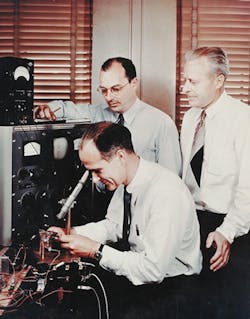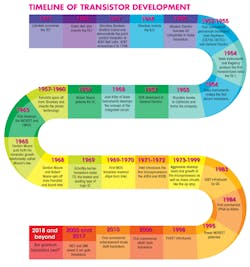As of Dec. 23, 2017, the transistor was officially 70 years old. The invention of the transistor may have been the greatest technology development of the 20th century. It has given us the integrated circuit and its progeny computers, TVs, smartphones, and all the other electronic stuff we use every day. We probably all owe our jobs to the invention of the transistor. So let’s take a moment to think about and celebrate this one monumental discovery.
The various historical records say that the transistor was invented Dec. 23, 1947 at AT&T’s Bell Laboratories by scientists William Shockley, John Bardeen, and Walter Brattain. On that day, they demonstrated transistor amplification with a point contact transistor. That transistor type was difficult to make. Shockley followed up with the invention of the bipolar junction transistor (BJT). Practical transistors came about quickly and rapid developments thereafter eventually lead to the integrated circuit (IC) and of course the microprocessor. The rest is history as many of us have experienced it.
The transistor was invented Dec. 23, 1947 at AT&T’s Bell Laboratories by scientists William Shockley, John Bardeen, and Walter Brattain.
The first transistor ever conceived was actually a field effect transistor (FET), the brainchild of Julius Lilenfeld in 1926 that was quickly patented. Later Oskar Heil put forth the same idea in 1934. Neither man actually produced a working device. That’s why the Bell Lab guys got all the credit, including a Nobel Prize in 1956. Shockley ultimately quit Bell Labs and moved to California to start a company making transistors. His company and the subsequent spin-offs started the semiconductor business. The transistor then begat the integrated circuit, which has given us everything electronic.
There have been many developments and patents in the meantime, too many to chronicle here. But the highlights of the transistor’s history and related developments are briefly summarized in the timeline below.
We have undoubtedly reached the physical limit for downsizing transistors. At the 5 nm manufacturing node, the gate size approaches that of the atoms and molecules. We simply cannot get any smaller thereby negating Moore’s.
So what’s next?
About the Author

Lou Frenzel
Technical Contributing Editor
Lou Frenzel is a Contributing Technology Editor for Electronic Design Magazine where he writes articles and the blog Communique and other online material on the wireless, networking, and communications sectors. Lou interviews executives and engineers, attends conferences, and researches multiple areas. Lou has been writing in some capacity for ED since 2000.
Lou has 25+ years experience in the electronics industry as an engineer and manager. He has held VP level positions with Heathkit, McGraw Hill, and has 9 years of college teaching experience. Lou holds a bachelor’s degree from the University of Houston and a master’s degree from the University of Maryland. He is author of 28 books on computer and electronic subjects and lives in Bulverde, TX with his wife Joan. His website is www.loufrenzel.com.


